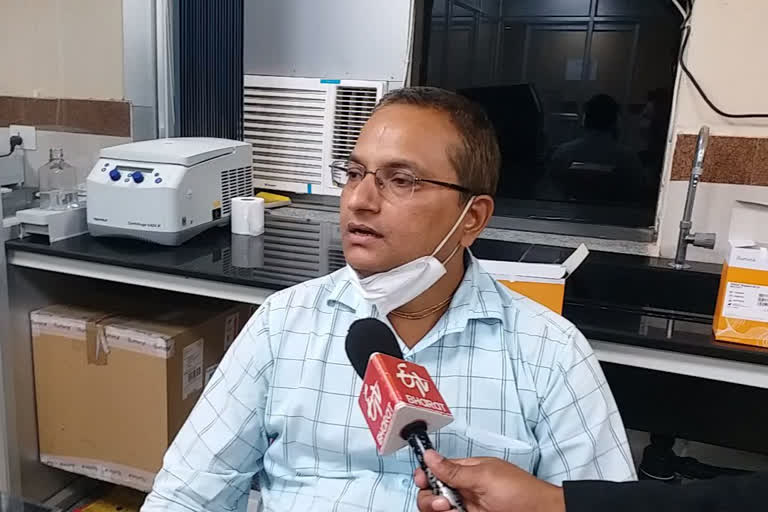Patna: The Bihar government has recently passed the orders that if a person with foreign travel history tests positive for Covid, the sample of that person should essentially be sent to the lab for genome sequencing. The only genome sequencing lab in the capital Patna is at Genome Sequencing Lab At IGIMS.
The ETV India team visited the IGIMS's Microbiology Lab and had an in depth conversation with the scientists there, to present an insight into what genome sequencing is, how exactly it works and how it may help detecting the new strain.
Dr. Abhay Kumar, Senior Scientist at the Department of Microbiology, IGIMS, said,"The machine of Misek Illumina Company was installed in AIIMS about one and half years ago for genome sequencing. This machine is an advanced platform for next generation sequencing. Sequencing means reading the entire sequence of any genetic material of the virus or bacteria."
He further informed that the Coronavirus is an RNA virus, in which 29 proteins are coded and its entire sequence is read. Alpha, Delta, Gamma or Omicron variants are determined based on this. He also highlighted that the genome sequencing machine in IGIMS is capable of reading large genomes. Dr Kumar further explained that as far as the working process of the machine is concerned, the process of genome sequencing is divided into 3 steps.
The first step is library preparation. In this process, the positive sample is separated into several smaller pieces. A nano chip is attached where sequencing takes place and binds to it. However, because the virus has a large genome of about 30 KB, the genome machine cannot read all of it at once.
The second step of the process is the NGS run, in which a cartridge with a sample capacity of 96 samples is used. Samples are loaded in it and a sequencing reaction occurs on the left side of the machine where the nano chip is attached. This is followed by a large amount of data production. Data is quite large in size and therefore a large server is installed nearby for the storage of this data. The IGIMS Lab has a server of 13 terabytes, wherein the data is stored.
The last step of this process is analysis. In this step, the data that is released during the process of genome sequencing is compared with other data to obtain parameters fro comparison. For example, it will give the scientists an idea about where the mutation from the oldest variant in the genome had occurred and how it differs from other variants an to what extent.
Also read: Spike gene of Omicron has 32 mutations, says CCMB Director
Dr. Abhay Kumar pointed out that the data analysis process requires a special expertise, called bioinformatics in medical terms. He told that he is accompanied by some other colleagues who are undergoing training in bioinformatics. There are two very important things for analysis - the first is the server and the second is the advanced software of the computer system. This is how sequencing is analyzed, he said.
He further informed that so far, two rounds of sequencing have been done with the genome sequencing machine of IGIMS. Of this, 70 percent are from Delta strains and the rest are from alpha strains. All the data that has been sequenced so far is from before October and of the archived samples. Samples from the second wave, when the number of positive cases and the casualties had increased significantly, have been considered for these rounds.
Giving information about the Omicron variant, Dr. Abhay Kumar said that like the Omicron variant, the Delta variant also had a lot of mutations. "The Omicron also contains the spike protein which is the most important, with the help of which the virus interacts with the cells of the body and slowly enters the body. At the time of the Delta variant, everyone thought it was the deadliest mutant of the virus. But surprisingly, the Omicron variant that has just emerged has more than 50 mutations in the spike protein and has taken the medical world by surprise," he informed.
Shedding some more light on the process, he said that spike proteins have two domains - one containing the receptor bound domain and the other containing the n-terminal domain. "The Omicron variant has significant mutations in both domains. There are a lot of mutations, especially in the receptor bound domain. This is the domain from which most effective vaccines have the binding capacity," he clarified.
The scientific community is highly concerned about whether any existing vaccine is effective against this new variant. Dr. Kumar said that the information about Omicron so far is that it spreads very fast, but it is not yet known how deadly it is. It is being studied in the areas where it has more cases, and in the next 2 weeks, information will be received about how deadly this variant can be, he informed.
A study is currently underway to see what effect this new variant is having on people who have been infected before and who have received both doses of the vaccine. Its effect on those who have not yet been vaccinated is also being monitored. On the other hand, Dr. Namrata Kumari, Head pf Department of Microbiology, IGIMS, stated that the whole process of genome sequencing takes a minimum of 10 days.
So far, the archived samples have been sequenced for study purposes and two runs of Genome Sequencing Machine have also been completed. Dr. Abhay Kumar, who is working as Senior Scientist in Department of Microbiology, IGIMS, is a geneticist. He has been working in the field of genome for the last 10 years.



